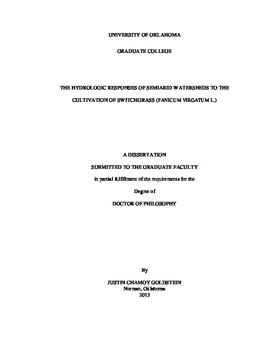| dc.contributor.advisor | Tarhule, Aondover | |
| dc.contributor.author | Goldstein, Justin Chamoy | |
| dc.date.accessioned | 2013-10-21T14:01:53Z | |
| dc.date.available | 2013-10-21T14:01:53Z | |
| dc.date.issued | 2013-12 | |
| dc.identifier.citation | Goldstein, Justin Chamoy. The Hydrologic Responses of Semiarid Watersheds to the Cultivation of Switchgrass (Panicum virgatum L.). PhD diss., College of Atmospheric & Geographic Sciences, The University of Oklahoma, 2013. | |
| dc.identifier.uri | https://hdl.handle.net/11244/6389 | |
| dc.description.abstract | Due in part to the very recent influx of federal and state policies promoting the development of ethanol as a gasoline additive, switchgrass (Panicum virgatum L.) has received much attention. Nevertheless, investigations of the hydrological responses to switchgrass production are few, with those existing largely interested in the Southern or Upper Midwestern regions of the United States. First, a contextualization of switchgrass as a potential biofuel crop vis-à-vis the history of land use change in the Great Plains region of the US is presented. Then, an investigation of the hydrologic responses of two Great Plains watersheds: a 1641 km2 portion of the Middle North Canadian watershed and the 1061 km2 Skeleton Creek Watershed to the cultivation of switchgrass using the semidistributed Soil and Water Assessment Tool (SWAT) hydrological model, specifically the hydrologic responses on total monthly and seasonal discharge, and evapotranspiration, are evaluated. Model results indicate that switchgrass cultivation is associated with decreased spring and summer seasonal runoff and increased spring and summer evapotranspiration relative to those under native land uses including native range grass and winter wheat. When the confounding impacts of changing precipitation and temperature patterns associated with climate change are considered, the impact of switchgrass cultivation on wintertime hydrology is a function of the particular General Circulation Model (GCM) utilized. With the addition of switchgrass, changes in surface runoff are amplified during the winter and summer and changes in evapotranspiration are amplified during all three seasons. Depending on the GCM utilized, either climate change or land use change (switchgrass cultivation) was the dominant driver of change in surface runoff while switchgrass cultivation was the major driver of changes in evapotranspiration. Therefore, any cultivation of switchgrass for biofuel production in the Great Plains region of the US must take into account hydrologic impacts and be accompanied by programs to ensure the sustainability of water supplies. | en_US |
| dc.language | en_US | en_US |
| dc.relation | A portion of this dissertation has been published as:
Goldstein JG, Tarhule AT. "Evaluating the Impacts of Climate Change and Switchgrass Production on a Semiarid Basin." Hydrological Processes 29(5), 724-738. http://dx.doi.org/10.1002/hyp.10159
Copyright © 2014, John Wiley & Sons, Inc. | |
| dc.relation.uri | http://dx.doi.org/10.1002/hyp.10159 | |
| dc.relation.uri | http://dx.doi.org/10.2166/nh.2013.163 | |
| dc.subject | Agriculture, Range Management. | en_US |
| dc.subject | Hydrology. | en_US |
| dc.subject | Agriculture, Agronomy. | en_US |
| dc.subject | Environmental Sciences. | en_US |
| dc.subject | Geography. | en_US |
| dc.subject | Physical Geography. | en_US |
| dc.subject | Sociology, Demography. | en_US |
| dc.title | The Hydrologic Responses of Semiarid Watersheds to the Cultivation of Switchgrass (Panicum virgatum L.) | en_US |
| dc.contributor.committeeMember | Greene, John | |
| dc.contributor.committeeMember | Hoagland, Bruce | |
| dc.contributor.committeeMember | Julian, Jason | |
| dc.contributor.committeeMember | Hong, Yang | |
| dc.date.manuscript | 2013-09 | |
| dc.thesis.degree | Ph.D. | en_US |
| dc.identifier.doi | | |
| ou.group | College of Atmospheric & Geographic Sciences | |
